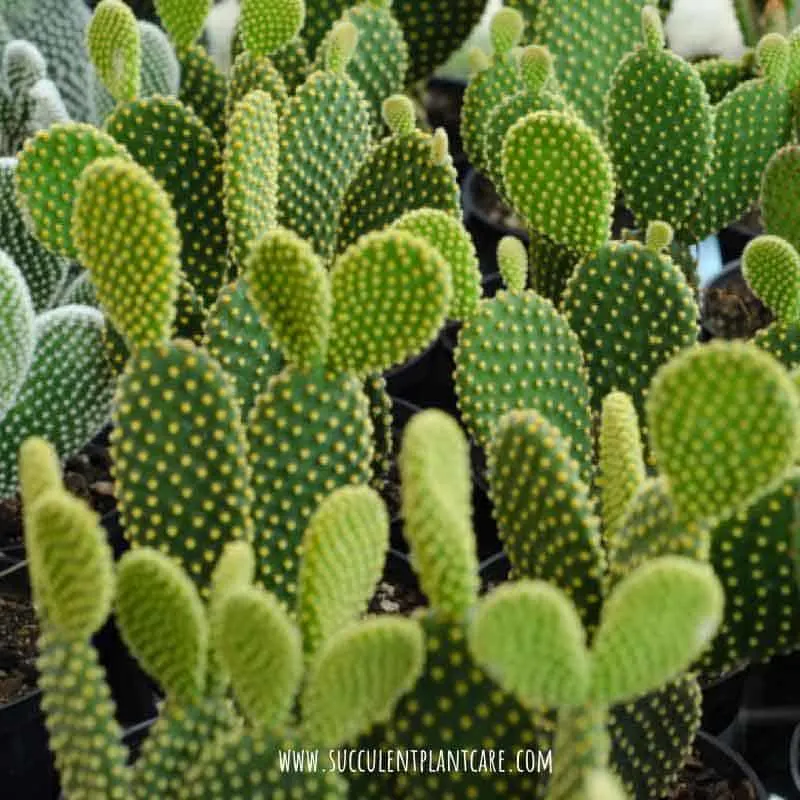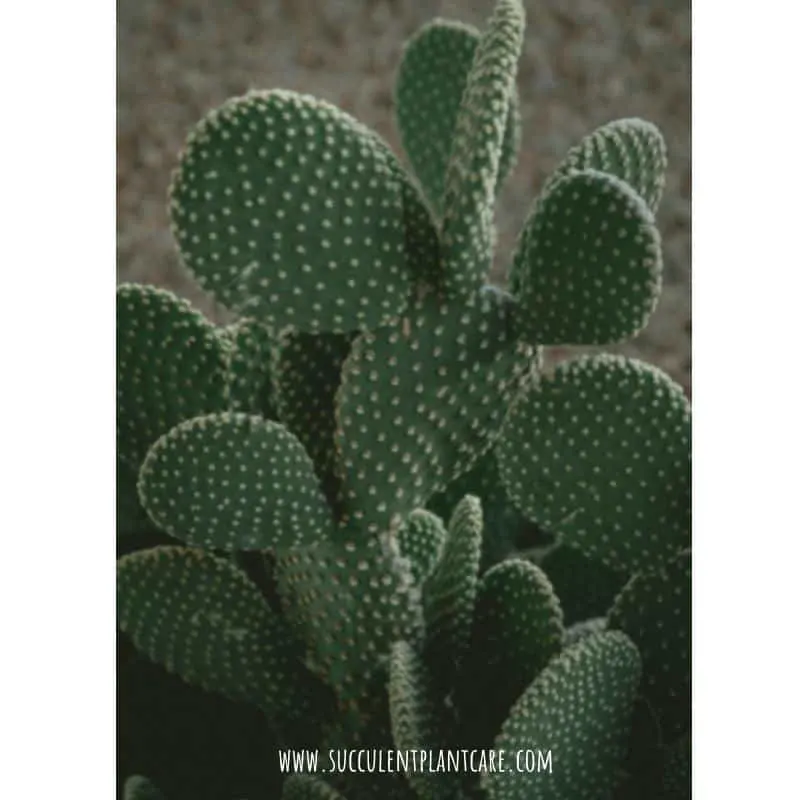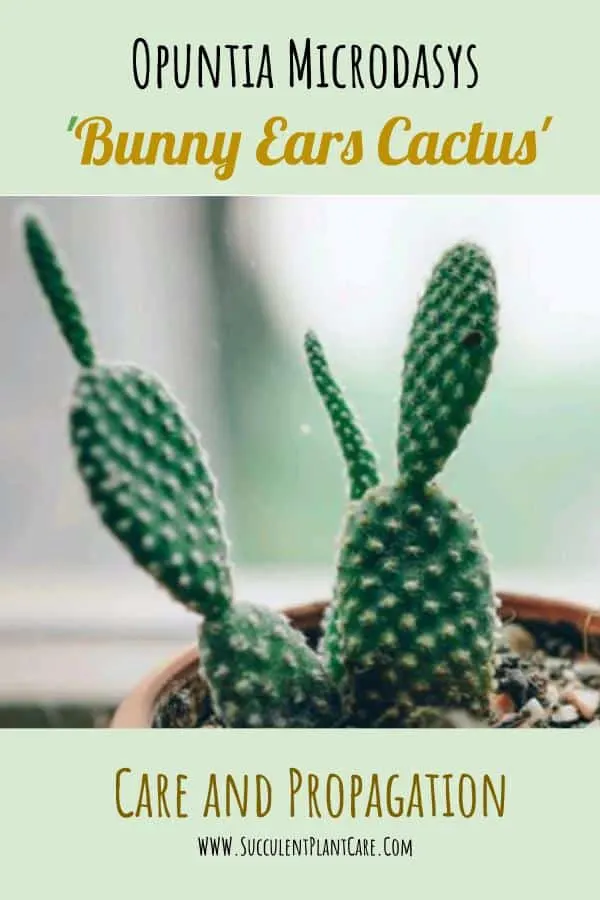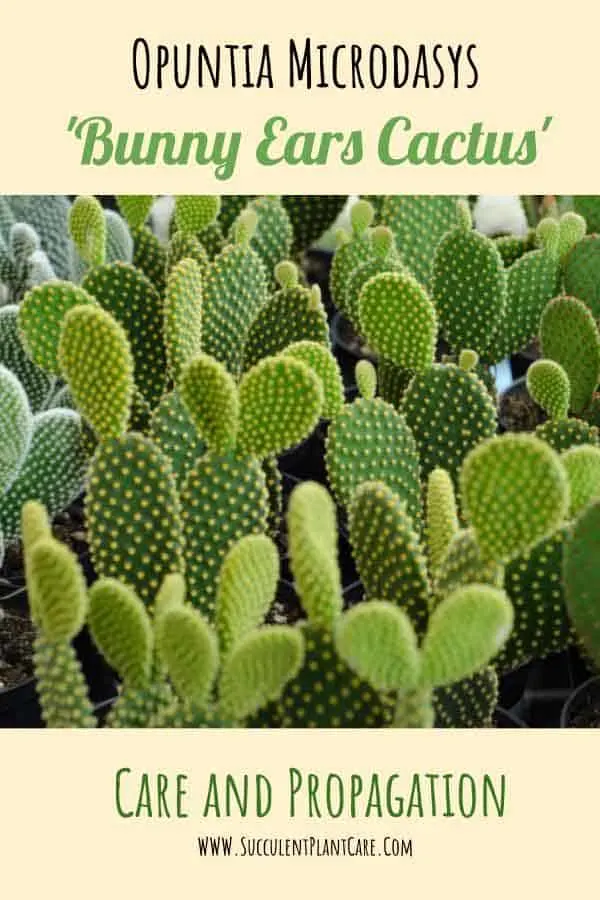The Opuntia Microdasys ‘Bunny Ears’ is a cactus that is native and endemic to central and northern Mexico. Other common names include ‘Angel’s Wings’, ‘Bunny Cactus’ and ‘Polka-Dot Cactus’. These cacti grow thick, segmented, succulent pads that are covered with glochids or short, bristly hairs.
These glochids come off easily from the pads and can be easily blown away by the wind. These pads grow in pairs, giving them the appearance of bunny ears. Don’t be fooled by the cute name and appearance. These plants are not as cuddly as they seem. Take care not to prick yourself with the spines that are easily dislodged from the pads of this plant.

Is it an Indoor or Outdoor Plant?
It can become an indoor houseplant but it is definitely more of an outdoor plant. This type of cactus is known for its ability to withstand arid and harsh environments. It can survive and thrive indoors if you mimic its natural habitat. It is one of the plants that beginners love because of how easy it is to grow and how low maintenance it is. When outdoors, it grows into a dense shrub ranging from 16 to 24 in. (40 to 60 cm) tall, sometimes more.
Indoor Lighting Requirements
The best area for your bunny ears cactus are the areas where there is plenty of sunlight. They are, after all, part of the cactus family. Ledges and window sills are ideal especially if they are facing south. Other ideal locations can be on an open terrace or any window facing the east or west. Placing the cactus on this strategic areas will ensure that it gets enough sunlight for it to grow. If your indoor space does not receive the ideal lighting that the cactus needs to grow and thrive, give it some outdoor time whenever possible so it can receive the sunlight that it needs. You can also consider using a grow light to help supplement the lighting requirements of this plant, especially during dark, rainy days. Here are some of my grow light recommendations.
A good rule of thumb for this prickly plant is that during winter months you need to find a location that is slightly cooler and with a little less direct sunlight from where it was before. If you don’t move it, it has a bigger chance of not surviving until the next spring. This actually has something to do with the temperature requirement it needs so that it can survive. The winter months are what experts call the dormant months for the bunny ears.
Outdoor Sunlight Requirements
Just like any species in the cactus family, if left to grow outside, it grows into its full height and width. Areas, where these plants can soak up as much sun as it can during the day, is a great location. The same concept applies here, any areas in the south, west or east are great places for this cactus to thrive. It might be a bit tricky for you to move this plant during the winter months especially if you planted it in the ground. But on the chance that you still planted it in a pot, follow the same steps given above. Find a cooler area for the cactus to remain dormant during the winter months where there is less sunlight than before. If done right, you might be rewarded with creamy yellow blooms that you can enjoy.

Frost Tolerance
According to experts, there are hundreds of cactus that can survive the winter, if the proper drainage in the soil is provided. It has been found that most cactus that die in the winter months is due to rotting from the excessive moisture they get.
For our little bunny ears cactus friend, the lowest temperature it can withstand is around 50 to 65℉ or 10 to 18℃. The cactus drains the excess water before winter so that it does not freeze during the cold months, which is why it is very important that you do not water it during this time.
You will need to protect this plant from frost by putting either burlap, frost blankets, or bed sheets (if you are more of a DIY person) over it. Ensure that the cover is not touching the plant by placing a framework that would hold the cover in place. This is usually done late in the afternoon and by people who planted bunny ears as part of their landscaping. I have narrowed down the choices for frost protection here on my frost protection resource page.
Soil Requirements
Bunny ears cactus require a special mix of potting soil for its root system to properly develop. You can either buy a pre-mixed one that is specifically concocted to meet the cactus requirements or you can mix one yourself. The main thing to remember is that the potting soil mix needs to drain well and it needs to be sandy or loose for the roots to spread properly.
If you want to mix your own cactus potting soil mix, you can try this simple and easy mixture: use a standard cactus mix and combine it with perlite (1:1 solution). You can also add coarse sand to the mix for added drainage (1:1:1 solution of cactus mix, perlite and coarse sand). Others recommend mixing 40% regular potting soil with 40% coarse sand plus 20% peat moss. The potting soil will provide the nutrients, the sand will make the potting soil loose and the peat moss will help retain some moisture after each watering.
To get some of these materials online, here are my soil and soil amendment recommendations. For more on cactus and succulent best soil practices, visit my post on “Best Soil and Fertilizer for Succulents and Cacti”.

Watering Requirements
Adult bunny ears cactus require watering when the top 1 inch of the soil is dry. Water it thoroughly and do not water again until the soil is dry. It is a good idea to have a pot that has drainage holes; otherwise, excess water can be trapped in the pot causing root rot. In the summer months, water every 7-14 days depending on how hot it gets and the humidity in your area.
In the winter months, many would advise you to not water your bunny ears. The rule is that you water your cactus very little, just enough to wet the root area of the plant, with a three to four weeks interval. This will help your adult bunny ears to have enough moisture during the winter but not too much that it starts to rot.
Also, the first year of the plant after it is repotted is a crucial stage for the roots to develop and spread properly. During this time, frequent watering is needed or else the roots will suffer and the integrity of the nutrient absorption of the plant is affected. Water about once every 7-14 days. Do not let the soil go bone dry as it can dry out the baby plant as well.
There are tools such as moisture meters and hygrometers to help you gauge the moisture level of the soil. Check out my resource page for moisture meter recommendations. For further information on watering, click on my post “How and When to Water Succulents and Cacti” for more details on this topic.
How to Propagate and Root the Plant
Before we go into how you can propagate this plant, you need to know that this plant has a self-defense mechanism that may irritate your skin. This self-defense is the tiny whitish-brown prickles that grow on its pads and these tiny prickles are easily dislodged by wind and slight touch.
Any mature pads from the plant can be picked and repotted to propagate more. It is best done during the summer where the roots of the newly potted plants have more time to grow and develop before the cold temp comes in.
Below is a step by step guide you can follow:
- Choose a mature pad that you want to separate from the mother plant. It is best to group your cuttings by threes or more for better chances of survival.
- Use a tweezer to break the pads off. Others would use rolled up newspaper or very thick gloves to handle this part.
- Let the cuttings or pads to callus for a few days before planting.
- Optional: Dip the pads in rooting hormone. While not necessary, rooting hormones can help speed up the rooting and propagation process.
- In the meantime, prepare your potting mix. You can buy a pre-mixed cactus potting soil in your local gardening store or you can mix your own (see Soil Requirements above for the recipe).
- Use a no glazed clay pot that is slightly larger than the pads/cuttings you will be re-potting. The clay pot helps the excess water to evaporate and lessens the chance of getting root rot.
- After your cuttings have callused, you can plant it one inch deep into the soil. This is deep enough to provide sturdiness and shallow enough for the roots to develop properly and avoid rot.
- Place it in an area where there is plenty of sunlight.
- Leave it alone for a few days and let the roots develop. If you are not sure if the roots have developed, you can give the cactus a bit of a wiggle. If there is resistance, then congratulations are in order. You can proceed to the next step.
- Lastly, water it regularly for the first year. This will help the roots develop and spread properly.
For more on how to root and propagate a cactus, visit my post on “How To Easily Root and Propagate a Cactus” for a more detailed, step by step guide. Your bunny ears cactus needs to be repotted in a bigger pot every one or two years. You can follow the same steps of how you potted your cuttings. Remember to leave it for a few days so that the roots have time to recover from the trauma and then water it regularly for the next year.

Blooms
Bunny ear cactus will bloom once a year during spring. Their flowers are creamy yellow in color and are found blooming towards the ends of the mature pads of the plant. The flowers can grow at a maximum diameter of 5 centimeters or 2 inches if the cactus is given the right condition and food which will then develop into purple fruits.
For the bunny ears cactus to bloom, it should be given the optimum care. If you plan to bloom a newly propagated bunny ears, you will need to set the environment right. Give it enough water for the first year for the roots to develop nicely and of course, place it in an area with ample sunlight during the spring and summer months. Move it to a cooler location with less sunlight during the winter months and don’t forget to water it very slightly every three to four weeks only.
Summer months require more watering but make sure that you let the water drain all the way and the soil dry up a bit before watering the plant the second time. You can use fertilizers to encourage growth if you want to but it is not necessary.
Those who are really growing this plant for the bloom also recommend giving fertilizers once a month after the first month of propagation and then every other water for the succeeding months. A balanced blend of fertilizer such as a or a fertilizer formulated for cacti and succulents diluted to half strength are both suitable and can be given to encourage blooms on the plant. Fertilizers are better applied at a quarter or half strength, about every two weeks during the growing season. Also, you will need to stop fertilization during the winter months because this is the dormant period for this plant. Here are some great fertilizers to choose from for your cacti: fertilizer recommendations.
Is the Opuntia Microdasys Toxic or Poisonous?
Although this cute looking, prickly plant is not poisonous to our pets, the tiny prickles that dot their whole body can cause irritation to our furry friends if swallowed. Contact your local veterinarian right away if you suspect poisoning or if large quantities are ingested.
Although not poisonous or toxic, these cacti are considered highly invasive in some parts of the world. In Australia, for instance, these plants are considered ecologically harmful and “reduces agricultural productivity over large areas of arid and semi-arid grazing land.” Do take care when planting these in the ground as they can easily spread and take over your landscape. To contain growth, it is not a bad idea to plant them in containers.
Wondering where to find an Opuntia Microdasys? Check out my resource page for recommendations on where to purchase these and other succulents and cacti online.
Pin this to save for later or share with others now!


